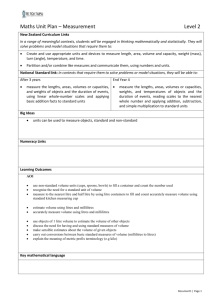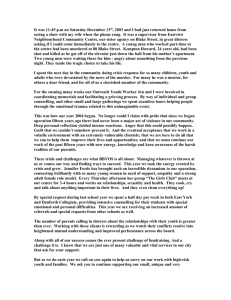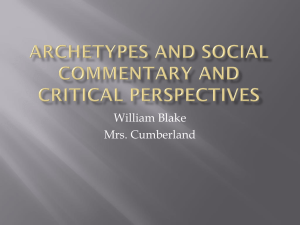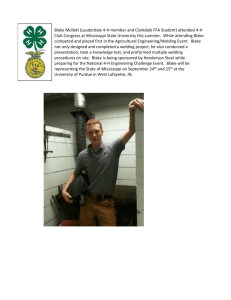Acting it Out - Blake Education
advertisement
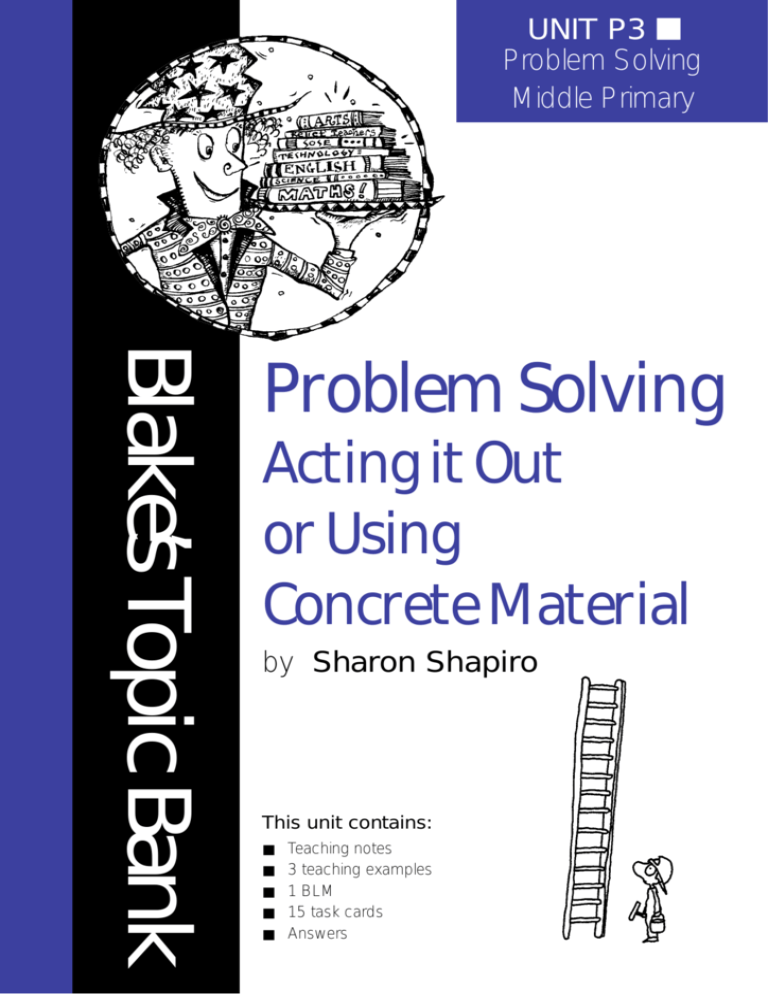
UNIT P3 ■ Problem Solving Middle Primary Blake’s Topic Bank Problem Solving Acting it Out or Using Concrete Material by Sharon Shapiro This unit contains: ■ ■ ■ ■ ■ Teaching notes 3 teaching examples 1 BLM 15 task cards Answers Problem Solving Acting it Out or Using Concrete Materials Sharon Shapiro Middle Primary THE PROBLEM SOLVING PROCESS It is important that students follow a logical and systematic approach to their problem solving. Following these four steps will enable students to tackle problems in a structured and meaningful way. STEP 1: UNDERSTANDING THE PROBLEM ❖ Encourage students to read the problem carefully a number of times until they fully understand what is wanted.They may need to discuss the problem with someone else or rewrite it in their own words. ❖ Students should ask internal questions such as, what is the problem asking me to do, what information is relevant and necessary for solving the problem. ❖ They should underline any unfamiliar words and find out their meanings. ❖ They should select the information they know and decide what is unknown or needs to be discovered.They should see if there is any unnecessary information. ❖ A sketch of the problem often helps their understanding. STEP 2: STUDENTS SHOULD DECIDE ON A STRATEGY OR PLAN Students should decide how they will solve the problem by thinking about the different strategies that could be used.They could try to make predictions, or guesses, about the problem. Often these guesses result in generalisations which help to solve problems. Students should be discouraged from making wild guesses but they should be encouraged to take risks. They should always think in terms of how this problem relates to other problems that they have solved.They should keep a record of the strategies they have tried so that they don’t repeat them. Some possible strategies include: ❖ Drawing a sketch, graph or table. ❖ Acting out situations, or using concrete materials. ❖ Organising a list. ❖ Identifying a pattern and extending it. ❖ Guessing and checking. ❖ Working backwards. ❖ Using simpler numbers to solve the problem, then applying the same methodology to the real problem. ❖ Writing a number sentence. ❖ Using logic and clues. ❖ Breaking the problem into smaller parts. STEP 3: SOLVING THE PROBLEM ❖ Students should write down their ideas as they work so they don’t forget how they approached the problem. ❖ Their approach should be systematic. ❖ If stuck, students should reread the problem and rethink their strategies. ❖ Students should be given the opportunity to orally demonstrate or explain how they reached an answer. STEP 4: REFLECT ❖ Students should consider if their answer makes sense and if it has answered what was asked. ❖ Students should draw and write down their thinking processes, estimations and approach, as this gives them time to reflect on their practices.When they have an answer they should explain the process to someone else. ❖ Students should ask themselves ‘what if ’ to link this problem to another.This will take their exploration to a deeper level and encourage their use of logical thought processes. ❖ Students should consider if it is possible to do the problem in a simpler way. © Blake Education—Problem Solving: Acting it Out or Using Concrete Materials For all your teaching needs visit www.blake.com.au 1 Teaching Notes Acting it Out or Using Concrete Materials Sometimes it can be hard for students to gain a concrete understanding of an abstract problem.To assist students who are finding it difficult to visualise a problem, or the procedure necessary for its solution, it is often helpful to use objects (concrete materials) to represent the people or things in the problem. A variety of objects such as counters, blocks, pencils or rubbers can be used to symbolise people or places.These objects can be moved through the steps of the problem. It is important to chart this movement to keep track of the process. It can also be very helpful for students to act out the roles of the different participants in the problem. Certain skills and understandings should be reinforced before students begin to work with this strategy. MOVING FROM ONE POSITION TO ANOTHER If the characters, or objects, featured in a problem move around a lot, it can be confusing and difficult to solve. By getting students to act out the problem, or using objects to act it out, the movements in the problem can be plotted. For example: The window cleaner was standing on the middle rung of the ladder cleaning the outside windows of the office block. He climbed up three rungs to clean some windows then saw a spot he had missed below him. He climbed down seven rungs to clean it and then climbed up the remaining ten rungs. He was now at the top of the ladder. How many rungs were there altogether on the ladder? Now ask the students to act out the problem. Draw a chalk ladder on the ground making each rung an equal distance apart. Indicate which direction is up the ladder with a chalk arrow, and mark the middle rung of the ladder. Choose a student to be the window cleaner. He or she should start by standing in the middle of the ladder.The student should walk for three rungs towards the top of the ladder.Then ask the student to turn and walk ‘down’ for seven rungs.Then turn and walk ‘up’ for ten rungs and mark that spot as the top of the ladder. Ask the students to count how many rungs there are back to the middle point. By counting the same number of rungs below the middle point, the students can calculate that the ladder has 13 rungs. A similar approach can be taken with the following problem. A spider is climbing up the side of a ten metre wall. Each hour it climbs three metres and then rests for one hour. During its rest the spider slips back one metre. How long till it reaches the top of the wall? Draw a ten metre line on the ground and use students, or an object, to show the movements of the spider. Ask other students to count one hour for every three metres the spider moves forward and one hour for each metre it slips back while resting. © Blake Education—Problem Solving: Acting it Out or Using Concrete Materials For all your teaching needs visit www.blake.com.au 2 Teaching Notes AMOUNTS Acting it Out or Using Concrete Materials OF MONEY Often amounts of money, or quantities of substances, are exchanged between the characters in a problem. Unless a means of visualising or acting out the problem is used, the result can be very confusing. This method is particularly helpful with more complex exchanges where students may not be able to write or explain the operations accurately. For example: Their grandparents sent Nick, Sally and Shirley $160, in total, for their birthdays.Their parents had to divide the money up so that Nick was given $20 more than Sally and $30 more than Shirley. How much were they each given? Ask three students to act out the parts of the children and use $160 play money for the exercise. Start by giving Sally an estimated amount. Give Sally $40. Nick should be given $20 more, $40 + $20 = $60 Shirley should be given $30 less than Nick, $60 – $30 = $30 Total $40 + $60 + $30 = $130.This total is too low. Start with a higher amount. container.Then I am left with three litres in a container.The correct amount remains. USING CONCRETE MATERIALS When a problem contains large numbers (of objects or people) it may not be practical to use students to act it out. Using concrete materials, such as counters or blocks, will assist students to work through the process. For example: John is queuing at the canteen. There are 50 people in front of him, but he is very impatient. Each time a student in the front is served, John slips past two students. How many people will be served before John reaches the front of the line? It will help students to visualise the movement in the problem by actually moving the counters or blocks to each new position. Give Sally $50 Nick should be given $50 + $20 = $70 Shirley should be given $70 – $30 = $40 Total $50 + $70 + $40 = $160.This is correct. SPECIFIC QUANTITIES Sometimes a problem requires students to measure out an exact quantity, but they do not have access to containers which can hold the correct amount. The students must come up with a way to accurately measure the required quantity using the containers they have. Acting out the process makes it easier to work out a solution. For example: If exactly three litres have to be poured into a container, and I only have a two litre and a five litre container, what can I do? I can fill a five litre container with water and pour off exactly two litres into the two litre © Blake Education—Problem Solving: Acting it Out or Using Concrete Materials For all your teaching needs visit www.blake.com.au 3 Teaching Examples Acting it Out or Using Concrete Materials EXAMPLE 1 Reflecting and generalising Two adults and two children have been stranded on an island in a river.They must cross the wide river to safety, but they only have one canoe.The canoe can either take one adult or two children at a time. How can they safely reach the other side? Using blocks to represent the movements of the family members made it easier to work through the steps of the problem and arrive at an accurate answer. Understanding the problem WHAT DO WE KNOW? There is one canoe. It can hold one adult or two children at a time. There are two adults and two children. Extension What if there were five people on the island instead of four (three children and two adults)? What if an adult and a child could fit in the canoe at the same time? How would this affect the speed of moving people off the island? WHAT DO WE NEED TO FIND OUT? Questioning: How can they safely leave the island? How many trips will it take? Planning and communicating a solution WHAT WE DID Students should label a block for each member of the family – A for each adult and C for each child. Demonstrate for the students how to write down each step, as below, so that steps are not duplicated. Students should create three areas. One for the island, the second for crossing the river and the third for the safe river bank. Remaining on the island Crossing the water Safe river bank AACC on the island AA remain AAC AC ACC A AC C CC CC C A C CC C A C CC CC C AC A ACC AC AAC AA AACC © Blake Education—Problem Solving: Acting it Out or Using Concrete Materials For all your teaching needs visit www.blake.com.au 4 Teaching Examples Acting it Out or Using Concrete Materials EXAMPLE 2 Reflecting and generalising In this example counters, blocks or students could be used to symbolise the characters in the problem. Blackie the cat was lying asleep on the middle step and the dog Kuja arrived and sat three steps above him. There were two steps between the dog and the top step. How many steps were there altogether? The problem is much easier to calculate once steps are made or drawn.Then it is simply a matter of counting the steps above Blackie and adding the same number below, plus the step Blackie is sitting on.The answer is concrete and accurate. Extension The problem can be extended by including additional animals or by moving animals to different steps. What if Blackie’s sister Poppy came and sat three steps above Kuja and then moved to the step second from the bottom? How many steps below Blackie would she be? How many steps did she move when she changed position? Understanding the problem WHAT DO WE KNOW? Blackie was lying on the middle step. Kuja sat three steps above. There were two steps between Kuja and the top step. WHAT WE HAVE TO FIND OUT? Questioning: How many steps were there altogether? How many steps were there below Blackie? Planning and communicating a solution WHAT WE DID Draw a staircase or make one out of blocks. Use a counter to show Blackie’s position in the middle of the staircase. Place a counter to represent Kuja, three steps above the Blackie counter. Leave two steps empty and then the third step should be the top step. Count with students to find out how many steps there are above Blackie and add the same number below Blackie’s position. There are six below and six above plus the middle step, so there are 13 steps altogether. Students can also act out the problem on some real steps or a flight of stairs. © Blake Education—Problem Solving: Acting it Out or Using Concrete Materials For all your teaching needs visit www.blake.com.au 5 Teaching Examples Acting it Out or Using Concrete Materials As each number is said, the students should sit down if they say an even number, or if they are using paper, cross out the even marks, or remove the even blocks. This should be done for two rounds of counting.They should then count how many students are still standing at the end.There were 8 students still standing at the end.After two rounds of counting we found half of a half, which is a quarter. Reflecting and generalising This problem is difficult to visualise because of all the changing factors. If students draw, create or use themselves in the problem the solution is easy to work out. EXAMPLE 3 Extension A class contained 32 students.The students were standing in a circle and began to count round the room starting from one, with each student saying one number. As they counted, all those who said even numbers sat down. Once each person had a turn, they continued counting (from 33) using only those students still standing.Again, every student who said an even number sat down. After the second round of counting how many students were still standing? (This problem can be done with different numbers of students, as long as the number is even.) This strategy can be used to reinforce all tables, square numbers or powers of numbers. Understanding the problem WHAT DO WE KNOW? There are 32 students all counting one number. If a student calls out an even number they sit down. Two rounds of counting are completed. WHAT DO WE NEED TO FIND OUT? Questioning: How many students will still be standing after a second round of counting? Planning and communicating a solution Students need to think of a way to visualise the class.They can ask the whole class to stand and act out the problem. If working individually or in pairs, they can use tally marks on paper, or have 32 blocks to represent the class. © Blake Education—Problem Solving: Acting it Out or Using Concrete Materials For all your teaching needs visit www.blake.com.au 6 BLM Acting it Out or Using Concrete Materials ★ Understanding the problem List what you know ★ What do you need to find out? Questioning : What questions do you have? What are you uncertain about? Is there any unfamiliar or unclear language? What are you being asked to do? ★ Planning and communicating a solution Which solution will you try? Are you moving from one position to another? Are you exchanging amounts of money? Are you trying to work out specific quantities without the use of appropriate containers? Will you use tally marks or objects to stand for things, or will people act out the problem? Explain what you did using mathematical language. ★ Reflecting and generalising How accurate is your answer? How can this strategy be applied to other situations? Could a more effective method have been used? What technology was useful? ★ Extension How can this problem be extended? What factors can be added as part of a ‘what if’ question? © Blake Education—Problem Solving: Acting it Out or Using Concrete Materials This page may be reproduced by the original purchaser for non-commercial classroom use. For all your teaching needs visit www.blake.com.au 7 PROBLEM SOLVING TASK CARDS Problem 1 Acting it Out or Using Concrete Materials Level Space 1 Five blocks have each been labelled with one of these letters – H, I, J, K, L. The H block is immediately to the right of the I block. The J block is to the right of the K block. The I is between the L and K. The L is immediately to the left of the I. Where is the K? Problem 2 Level Space 1 Place 14 blocks in three piles. The first pile should have one less than the third. The third pile should have twice as many as the second. How many blocks are there in each pile? Problem 3 Measurement Level 1 Four students measured their heights. Nicky was taller than Kelly, but not as tall as Tali. Gene was taller than Tali. Write down their names in order of their heights, from shortest to tallest. © Blake Education—Problem Solving: Acting it Out or Using Concrete Materials This page may be reproduced by the original purchaser for non-commercial classroom use. For all your teaching needs visit www.blake.com.au 8 PROBLEM SOLVING TASK CARDS Problem 4 Acting it Out or Using Concrete Materials Measurement Level 1 George has a one litre bottle of lemonade. He pours half of the lemonade out into a jug, then gives the bottle to Jenny. Jenny is pours half of what’s left in the bottle into two large tumblers. Then she hands the lemonade bottle to James. James pours half of what’s left in the bottle into a plastic cup. How much lemonade is left in the bottle? What fraction of a litre is this? Problem 5 Number 1 23 Level 1 At a party every guest shakes hands with every one of the other 12 guests. How many handshakes were there? Problem 6 Number 1 23 Level 1 Twenty nine students were waiting in a line to play a game. The teacher chose the first person in the line and then every fourth person in the line after that. How many were chosen? © Blake Education—Problem Solving: Acting it Out or Using Concrete Materials This page may be reproduced by the original purchaser for non-commercial classroom use. For all your teaching needs visit www.blake.com.au 9 PROBLEM SOLVING TASK CARDS Problem 7 Acting it Out or Using Concrete Materials Level Space 2 Mrs Peters has four squares of yellow cardboard. She asks her class to join them all so they are connected by at least one edge? How many different ways can you do this? Problem 8 Level Space 2 Five students are sitting in a row of chairs along one side of the room. Jennifer sits beside Alison but not beside Peta. Steven sits in the second seat on the left. Alison sits between (but not necessarily next to) David and Peta. Steven sits beside David. Who sits in the middle seat? Problem 9 Measurement Level 2 At the water tap there are only three litre and five litre containers. The children must pour exactly seven litres of water into a tub. How can they measure exactly seven litres? © Blake Education—Problem Solving: Acting it Out or Using Concrete Materials This page may be reproduced by the original purchaser for non-commercial classroom use. For all your teaching needs visit www.blake.com.au 10 PROBLEM SOLVING TASK CARDS Problem 10 Number Acting it Out or Using Concrete Materials 1 23 Level 2 Each time a student did something helpful, Mrs Turner removed one jelly bean from container B and placed it in container A. If a student did something unhelpful she did the reverse. Container A had more jelly beans than container B. Mrs Turner took three jelly beans from container A and put them in container B. Then from container B she took two jelly beans to put in container A. Both containers then had eight jelly beans. How many were in each container in the beginning? Problem 11 Number 1 23 Level 2 Imagine that you bought a game for $15, then sold it for $20 because you no longer played with it. Then you bought it back for $25 because your sister wanted it. Finally, when you sister got bored with the game, you sold it for $30. How much money did you make or lose? Problem 12 Space Level 3 Three children walk down a fifteen step fire escape. Lisa walks down one step at a time. She begins by putting her left foot on the first step. Alex is in a hurry and walks down two steps at a time, starting with his right foot. He starts on the second step. Joel is in even more of a hurry and takes three steps at a time, beginning on the third step with his left foot. Which step will be the first one they all step on? Will all the children stand on the same step with their left foot? © Blake Education—Problem Solving: Acting it Out or Using Concrete Materials This page may be reproduced by the original purchaser for non-commercial classroom use. For all your teaching needs visit www.blake.com.au 11 PROBLEM SOLVING TASK CARDS Problem 13 Acting it Out or Using Concrete Materials Level Space 3 An extended family was stranded on an island by freak floods. There were four adults and two children who needed to get off the island in a small rowing boat. The boat can carry two children or one adult. How many trips does the boat have to take in order to carry everyone to safety? Problem 14 Measurement Level 3 A woman wants to collect exactly four litres of water from the well for her family. She only has two containers, one that can carrry five litres and one that can carry seven litres. How can she measure out exactly four litres or water? Problem 15 Number 1 23 Level 3 The same number of seats has been placed in each row at the theatre. Mrs Abrams chair is in the third row from the front, and the eighteenth row from the back. Mrs Dave’s seat has eight chairs to the left of it and eleven chairs to the right. How many chairs are there in the theatre? © Blake Education—Problem Solving: Acting it Out or Using Concrete Materials This page may be reproduced by the original purchaser for non-commercial classroom use. For all your teaching needs visit www.blake.com.au 12 Answers to Task Cards Problem 1 Problem 8 K is the second block from the right. Jennifer sits in the middle seat. L I H K J David, Steven, Jennifer, Alison, Peta Problem 2 Problem 9 The first pile has five blocks, the second pile three blocks and the third pile six. The children should fill the five litre container with water.Then they should pour three of the five litres of water into the three litre container leaving exactly two litres in the five litre container.They should pour these two litres into the tub and then refill the five litre container and pour that into the tub.There will now be seven litres of water in the tub. Problem 3 The order of the students’ heights, from shortest to tallest, is Kelly, Nicky,Tali, Gene. Problem 4 Problem 10 The lemonade bottle has 125 ml left in it. This is –18 of a litre. Container A started with nine jelly beans and container B started with seven jelly beans. Problem 5 Problem 11 There were 66 handshakes. You made $10 profit. The first person shook eleven hands, the second person only needed to shake ten hands, because she had already shaken the hand of the first person. Buy Sell Profit $15 – $15 $20 + $5 $25 – $20 The third person shook nine hands, and so on. So, 11 + 10 + 9 + 8 + 7 + 6 + 5 + 4 + 3 + 2 + 1 = 66 Eight students were chosen. x x $30 + $10 Problem 12 Problem 6 x Loss x x x x x 1.They will all step on the sixth step with their right foot. 2. No, they do not all stand on the same step with their left foot. Problem 7 You can connect the four yellow squares of cardboard five different ways. 1 2 3 4 5 6 7 8 9 Lisa L R L R L R L R L Alex Joel R L L R R L L © Blake Education—Problem Solving: Acting it Out or Using Concrete Materials This page may be reproduced by the original purchaser for non-commercial classroom use. For all your teaching needs visit www.blake.com.au 13 10 11 12 13 14 15 Lisa R L R L R L Alex R Joel L R The woman should take the seven litre container and fill it with water.Then she should pour five litres of water from the seven litre container into the five litre container.This will leave two litres remaining in the seven litre container. She should then empty the five litre container and pour into it the two litres from the seven litre container. She should fill the seven litre container again and then pour from the seven litre container into the five litre container (which still has two litres of water in it) until it is full.This will leave exactly four litres in the seven litre container. R L Problem 13 It will take 17 trips to rescue the family from the island. Island (A1 A2 A3 A4 CC) A1 A2 A3 A4 A1 A2 A3 A4 C A1 A2 A3 C A1 A2 A3 CC A1 A2 A3 A1 A2 A3 C A1 A2 C A1 A2 CC A1 A2 A1 A2 C A1 C A1 CC A1 A1 C C CC Crossing river CC C A4 C CC C A3 C CC C A2 C CC C A1 C CC Problem 14 Safety Problem 15 The theatre has 400 seats (20 across and 20 from front to back). CC C A4 C A4 A4 CC A4 C A4 A3 C A3 A4 A3 A4 CC A3 A4 C A2 A3 A4 C A2 A3 A4 A2 A3 A4 CC A2 A3 A4 C A1 A2 A3 A4 C A1 A2 A3 A4 A1 A2 A3 A4 CC Front 1 2 3 4 5 6 7 8 9 10 11 12 13 14 15 16 17 18 19 20 Back Mrs Abrams Left side 1 2 3 4 5 6 7 8 1 2 3 4 5 6 7 8 9 10 11 Right side Mrs Dave © Blake Education—Problem Solving: Acting it Out or Using Concrete Materials This page may be reproduced by the original purchaser for non-commercial classroom use. For all your teaching needs visit www.blake.com.au 14
